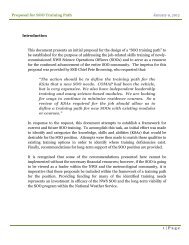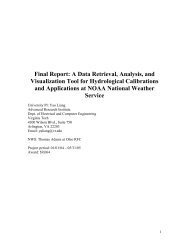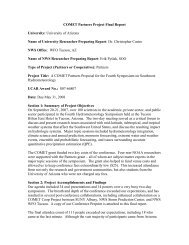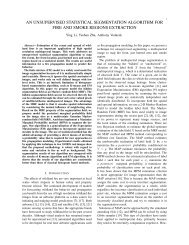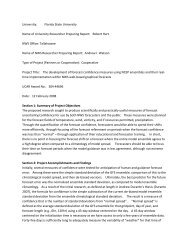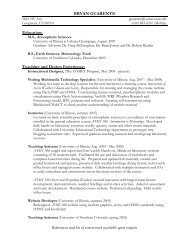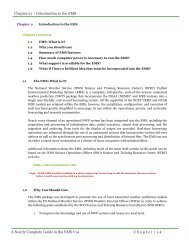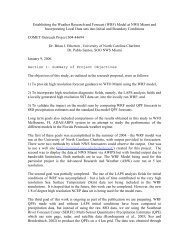FORT COLLINS FLOOD 1997: COMPREHENSIVE VIEW ... - COMET
FORT COLLINS FLOOD 1997: COMPREHENSIVE VIEW ... - COMET
FORT COLLINS FLOOD 1997: COMPREHENSIVE VIEW ... - COMET
Create successful ePaper yourself
Turn your PDF publications into a flip-book with our unique Google optimized e-Paper software.
<strong>FORT</strong> <strong>COLLINS</strong> <strong>FLOOD</strong> <strong>1997</strong>: <strong>COMPREHENSIVE</strong> <strong>VIEW</strong> OF AN<br />
EXTREME EVENT<br />
By Neil S. Grigg, 1 Fellow, ASCE, Nolan J. Doesken, 2 David M. Frick, 3 Member, ASCE,<br />
Mike Grimm, 4 Marsha Hilmes, 5 Thomas B. McKee, 6 and Kevin A. Oltjenbruns 7<br />
ABSTRACT: The July <strong>1997</strong> flood in Fort Collins was caused by the heaviest rains ever documented over an<br />
urbanized area in Colorado, and offers a data base and multifaceted set of lessons about flood planning, mitigation,<br />
response, and recovery for engineers, flood managers, and urban officials. The storm dropped 10 to 14<br />
inches in 31 hours and some peak discharges greatly exceeded projected 100-year and 500-year flows. Five<br />
people died, 54 were injured, about 200 homes were lost, and 1,500 homes and businesses were damaged.<br />
Damages at Colorado State University were about $100,000,000, including catastrophic losses to the library.<br />
The paper summarizes the flood experience and provides lessons in five categories: urban drainage and flood<br />
control, risk management, mitigation, flood response, and public involvement.<br />
INTRODUCTION<br />
On July 28, <strong>1997</strong>, an extreme flood disaster hit Fort Collins,<br />
Colorado with the heaviest rains ever documented in an urbanized<br />
area of the state. It was one of the major urban floods<br />
of recent years in the United States and was labeled a ‘‘500-<br />
year event’’ by the media, causing major impacts on the city<br />
and its people. This postflood analysis describes the causes,<br />
consequences, and lessons of the event.<br />
A flood should be viewed from several different perspectives.<br />
The examination in this paper includes views from meteorology,<br />
hydrology and hydraulics, planning and mitigation,<br />
response and recovery, and public reaction. In addition, the<br />
paper contains a unique description of a university’s response<br />
to a major campus flood. The writers draw from their own<br />
studies and from the Flood ’97 Conference at Colorado State<br />
University, which compiled first-hand accounts from persons<br />
who dealt with the flood.<br />
The city manager’s report (Fischbach <strong>1997</strong>) showed five<br />
people dead, 54 people injured, 200 homes destroyed, and<br />
1,500 homes and businesses damaged throughout the City.<br />
Four of the five deaths were residents in a trailer park, and<br />
one was a resident downstream, near the trailer park. Other<br />
parts of town also had frightening experiences and intense<br />
damage. The City spent about $5,000,000 on flood recovery,<br />
most of which it will recover from the federal government and<br />
insurance.<br />
CONTEXT OF THE <strong>FLOOD</strong><br />
Complacency about floods in semiarid areas exists because<br />
of their infrequency. But although the <strong>1997</strong> flood caught the<br />
community by surprise, Fort Collins had experienced a great<br />
deal of flooding in the past and had reason to be vigilant. In<br />
1<br />
Prof. and Head, Dept. of Civ. Engrg., Colorado State Univ., Fort Collins,<br />
CO 80523.<br />
2<br />
Asst. State Climatologist, Colorado State Univ., Fort Collins, CO.<br />
3<br />
Reg. Vice Pres., Ayres and Assoc., Fort Collins, CO.<br />
4<br />
Floodplain Engr., Federal Emergency Management Agency, Mitigation<br />
Directorate, Hazards Study Branch, Washington, DC 20472.<br />
5<br />
Flood Plain Administrator, City of Fort Collins, CO.<br />
6<br />
State Climatologist and Prof. of Atmospheric Sci., Colorado State<br />
Univ., Fort Collins, CO.<br />
7<br />
Assoc. Prof., Dept. of Human Development and Family Studies, Colorado<br />
State Univ., Fort Collins, CO.<br />
Note. Discussion open until March 1, 2000. To extend the closing date<br />
one month, a written request must be filed with the ASCE Manager of<br />
Journals. The manuscript for this paper was submitted for review and<br />
possible publication on July 23, 1998. This paper is part of the Journal<br />
of Water Resources Planning and Management, Vol. 125, No. 5, September/October,<br />
1999. ASCE, ISSN 0733-9496/99/0005-0255–0262/<br />
$8.00 $.50 per page. Paper No. 18718.<br />
fact, notable past floods in Fort Collins’ history include the<br />
events of 1864, 1891, 1902, 1904, 1938, 1951, 1977, and 1992<br />
(Charlie <strong>1997</strong>). The original town, a military post called Camp<br />
Collins, moved to its present site after the flood of 1864.<br />
The September 1902 flood was caused by about 6.2 inches<br />
of rain in 48 hours. The City had significant damage, but the<br />
campus had few buildings and suffered little. Two people died<br />
during the 1904 flood. By 1938 the campus was vulnerable,<br />
and on September 2–3, 1938, 4.6 inches of rain in about 48<br />
hours flooded five buildings on the Oval, similar to the <strong>1997</strong><br />
flood. In 1951, on August 3, 6.06 inches of rain fell in 27<br />
hours, with 3 inches in 3 hours. Again, buildings on the Oval<br />
flooded. A number of improvements were completed, mainly<br />
storm sewers, but these helped little during the flood of <strong>1997</strong>,<br />
for they were simply overwhelmed. Spring Creek, the site of<br />
the main disasters in <strong>1997</strong>, also experienced serious flooding<br />
in 1951.<br />
Meanwhile, near Fort Collins, the August 1976 flash flood<br />
on the Big Thompson River killed 139 people within a few<br />
hours (McCain 1979). Six to ten inches of rain fell over a<br />
wide area of the basin and the estimated peak discharge was<br />
more than four times the previous maximum during 88 years<br />
of record. Prior floods on several other streams in the foothills<br />
had approximately equaled the Big Thompson experience.<br />
Another recent Colorado flood occurred in 1965, along the<br />
foothills. Peak discharges were caused by heavy, intense rain<br />
that fell over a three-day period when the ground was already<br />
wet, similar to the Fort Collins experience but longer-lasting.<br />
Rain cells with maximum depths of 14 inches were widespread,<br />
and peak discharge of the South Platte River through<br />
Denver was 40,300 cfs, some 1.8 times the previously recorded<br />
peak of 22,000 cfs (record starting in 1889). Eight<br />
deaths were attributed to the floods, and about $508,000,000<br />
in property damage occurred, mostly in the Denver area (Matthai<br />
1969).<br />
These previous flood experiences illustrate the susceptibility<br />
of Fort Collins and the Front Range to infrequent severe flooding,<br />
and set the context for the flood of <strong>1997</strong>.<br />
STORM<br />
The storm that caused the flood of <strong>1997</strong> received much attention<br />
from the meteorological community because it produced<br />
‘‘atypical rainfall and urban runoff complexities’’<br />
(Kelsch 1998). Although interesting for its size, the storm also<br />
highlights several lessons for urban stormwater managers.<br />
After a day of heavy rain, a deluge of about six inches fell<br />
suddenly in an hour and a half, producing peak flows all<br />
around town and causing much damage in the City and at<br />
Colorado State University. As Fig. 1 shows, the maximum<br />
JOURNAL OF WATER RESOURCES PLANNING AND MANAGEMENT / SEPTEMBER/OCTOBER 1999 / 255
FIG. 1.<br />
Maximum Rainfall in Western Part of City<br />
rainfall occurred in the western part of the City, and the two<br />
major centers of damage were along Spring Creek and at Colorado<br />
State University.<br />
Weather patterns leading to the flood illustrate how flash<br />
floods occur suddenly. In the weeks leading up to the flood,<br />
Fort Collins and vicinity experienced six weeks of predominantly<br />
hot and very dry weather. But in the last week of July<br />
the humidity increased as moist tropical air drifted northward.<br />
On Sunday the 27th, a fairly strong cold front moved southward<br />
into the region and served as the trigger to help initiate<br />
numerous storms over northern Colorado late that afternoon.<br />
As this weather pattern developed, many meteorologists noted<br />
the strong similarity to weather conditions associated with previous<br />
flash floods—the Rapid City storm of June 9, 1972, and<br />
the Big Thompson flood of July 31, 1976, for example.<br />
The first round of storms, late on Sunday afternoon, was<br />
not unusual. Small, localized storms, complete with crashing<br />
thunder and gusty winds, brought torrents of rain to areas in<br />
the lower foothills just west and northwest of Fort Collins<br />
between 5 and 6 p.m. MDT. After dropping as much as 2.4<br />
inches of rain near the south end of Horsetooth Reservoir, the<br />
storms quickly diminished and brought only a light shower to<br />
most of the city. But instead of clearing off after dark—the<br />
normal summer weather pattern—moist southeasterly winds<br />
strengthened. Low, dark clouds hugged the foothills. Late at<br />
night, rains developed again, but this time with a different<br />
character. Steady rains without the accompaniment of lightning<br />
or thunder expanded along the base of the foothills. Areas<br />
two or more miles east of the foothills again received relatively<br />
light rains, but at the immediate base of the foothills, heavy<br />
rainfall was noted. A gloomy July 28 dawn brought a temporary<br />
break in the rainfall, but then downpours began again,<br />
this time even more localized. While most of Fort Collins had<br />
a cloudy, cool morning, rain poured along the base of the<br />
foothills from 8 a.m. to noon.<br />
A detailed time history of the storm is given by Doesken<br />
and McKee (1998) from their analysis of rainfall reports gathered<br />
from citizen observers at more than 300 locations in and<br />
near Fort Collins. Unknown to most residents of Fort Collins,<br />
6–10 inches of rain had already fallen by midday July 28 from<br />
the north end of Horsetooth Reservoir to northwest of the<br />
small town of Laporte. Areas west and southwest of Fort Collins<br />
received 2–4 inches of rain. Flooding was severe during<br />
the day in and near Laporte.<br />
Rainfall abated across the region Monday afternoon (July<br />
28). However, high-humidity air continued in place and,<br />
around 6 p.m. MDT, bands of heavy showers began again.<br />
Once more, the heaviest showers were concentrated near the<br />
foothills. As the evening progressed, rains increased. Around<br />
8:30 p.m., after more than two hours of heavy rain, the rains<br />
diminished east and southeast of the city. At this same time,<br />
the storm’s intensity increased in western portions of Fort Collins.<br />
From 8:30 to 10 p.m., the heaviest sustained rainfall of<br />
record, with rainfall rates occasionally reaching 6 inches per<br />
hour over southwest Fort Collins, inundated the city and sent<br />
huge volumes of runoff flowing downhill across the city from<br />
west to east. After this awesome crescendo of rainfall, the rains<br />
ended mercifully and abruptly between 10 and 10:30 p.m. in<br />
southwest Fort Collins with lighter rains continuing north of<br />
town until after 11 p.m.<br />
When the evening storm was over, more than 10 inches of<br />
rain had fallen in the Spring Creek basin, in southwest Fort<br />
Collins, with 5 to 8 inch totals widespread over the western<br />
half of the city. Remarkable rainfall gradients were noted<br />
southeast of the storm center with less than 2 inches of rainfall<br />
over most of southeast Fort Collins. In fact, many citizens<br />
were unaware of the raging flood waters heading eastward.<br />
Since hourly data were first published for Fort Collins in<br />
1940, several storms have had one-hour rainfall totals exceeding<br />
2 inches. However, most intense storms in this area have<br />
relatively short lives, and no 6-hour period has ever come<br />
close to dropping as much rainfall on campus as the 5.3 inches<br />
that fell from 6–10:30 p.m. July 28, <strong>1997</strong> (McKee and Doesken<br />
<strong>1997</strong>).<br />
Overall, 10–14.5 inches of rain fell over an approximately<br />
30-hour period in a band extending along the base of the foothills<br />
from southwest Fort Collins northward to northwest of<br />
Laporte (Fig. 2). Rainfall of this intensity is rare, but storms<br />
of similar magnitude, such as the Big Thompson flood of July<br />
1976, have been observed roughly once every 10–20 years<br />
somewhere in Colorado, with a distinct preference for being<br />
in or near the eastern foothills of the Rocky Mountains<br />
(McKee and Doesken <strong>1997</strong>).<br />
FIG. 2. Rainfall (Inches) for Fort Collins, Colo., 4 p.m. MDT<br />
July 27 through 11 p.m. MDT July 28, <strong>1997</strong><br />
256 / JOURNAL OF WATER RESOURCES PLANNING AND MANAGEMENT / SEPTEMBER/OCTOBER 1999
Meteorological information from the Fort Collins flood, as<br />
summarized above and described in McKee and Doesken<br />
(<strong>1997</strong>), Kelsch (1998), and Petersen et al. (1999), offers insights<br />
that aid engineers in understanding flash flooding and<br />
in explaining hazards to local officials and the public, thereby<br />
fighting complacency. In this case, the time-wise development<br />
of the storm’s intensity created unusually severe runoff effects,<br />
which are described in the next section. The unique program<br />
operated by the Colorado Climate Center—which relies on<br />
local, citizen-operated weather stations—also offers lessons<br />
for improving hydrologic data without added expense.<br />
RUNOFF<br />
While the storm was remarkable, the runoff was at least as<br />
dramatic, with magnitudes greatly exceeding estimated 100-<br />
year and 500-year flows in some places (Table 1). This illustrates<br />
that these estimated flows should be used cautiously,<br />
especially when vulnerable facilities are exposed, as they were<br />
in Fort Collins.<br />
A brief explanation of the runoff event will set the context<br />
for the flood’s damage. Hydraulically, the two main flow paths<br />
that caused greatest damage during the flood were along<br />
Spring Creek and through the Colorado State University campus<br />
(Fig. 1).<br />
As shown in Table 1, the City of Fort Collins made an<br />
analysis of peak flows in different parts of the City to compare<br />
them with previously estimated 100- and 500-year flows<br />
(Hilmes <strong>1997</strong>). Note that along Spring Creek, where major<br />
damage occurred, actual flows exceeded the previously estimated<br />
levels by factors of two or more. For the ‘‘combined<br />
flow below canals’’ on Spring Creek, the discharge was 8,250<br />
cfs while the FEMA 500-year discharge was 3,325 cfs, an<br />
exceedance factor of 2.48 (Note: The authors recognize that<br />
flood magnitudes are not known to three significant figures,<br />
but the city’s basic data were used in this calculation). This is<br />
the point where water ponded behind a railroad embankment,<br />
swept four rail cars off the tracks, and overtopped the tracks,<br />
resulting in flooding of the trailer park to the east and the loss<br />
of lives. Downstream of College Avenue, the discharge decreased<br />
to about 5,000 cfs due to storage behind the railroad<br />
embankment, illustrating the storage effect of an embankment.<br />
The storm greatly exceeded the capacity of storm-water facilities<br />
in the City, which are designed for 2–100 years frequency.<br />
By 8:30 p.m., when more than 3 inches of rain had<br />
fallen, detention ponds began overtopping and there was no<br />
storage available for the additional 6 inches of rain that fell in<br />
the next hour and a half. The College Avenue bridge was<br />
blocked by trailers, and many arterial streets were overtopped<br />
and damaged.<br />
Irrigation canals in the West are important drainage features,<br />
not because they can convey much water, but because they<br />
appear to have capacity but in reality are so flat that they only<br />
can capture and convey small quantities of runoff. In Fort Collins,<br />
floods with recurrence intervals greater than 25 years<br />
overtop these canals and head east toward town and the university.<br />
On the campus, as shown in Fig. 3, water generally flows<br />
from west to east. During minor events, most water is captured<br />
by the storm sewer system and does not affect the campus;<br />
but in larger events, water ponds and overflows. Flows on<br />
campus were estimated by using rainfall data from the <strong>1997</strong><br />
event and modeling to estimate discharges at various points<br />
on the campus. As shown by Fig. 3, they greatly exceeded the<br />
anticipated 100-year flows estimated in an engineering study<br />
(Frick <strong>1997</strong>).<br />
For example, at Elizabeth and Shields Streets the estimated<br />
peak discharge entering the campus was 1870 cfs (Fig. 3),<br />
compared to a projected 100-year value of 490 cfs. The estimated<br />
flow from the Lagoon area into the Engineering parking<br />
lot was 930 cfs, compared to a projected 100-year value of 50<br />
cfs. The estimated flow through the railroad embankment—<br />
near the heating plant, and where flooding had occurred in<br />
1938 and 1951—was 320 cfs, compared to a projected 100-<br />
year flow of 40 cfs.<br />
At the College Avenue Gym, at the east border of campus,<br />
TABLE 1.<br />
Preliminary Discharge Estimates<br />
Location<br />
(1)<br />
July 28, <strong>1997</strong> discharge<br />
(cfs)<br />
(2)<br />
FEMA 100-year discharge<br />
(cfs)<br />
(3)<br />
FEMA 500-year discharge<br />
(cfs)<br />
(4)<br />
Spring Creek<br />
Taft Hill Road 3,900 1,492 2,347<br />
Downstream of Taft Hill 3,300 1,492 2,347<br />
Drake Road 4,200 1,635 2,575<br />
Downstream of Drake Road 3,700 1,635 2,575<br />
DS Shields above Canals 5,200 1,955 3,090<br />
Combined flow below Canals 8,250 2,135 3,325<br />
Drop Structure—Channel 6,100 — —<br />
Overflow to South 850 — —<br />
Wallenberg 1,300 — —<br />
Indian Meadows Condos — 1,528 1,846<br />
Indian Meadows Condos 5,000 1,528 1,846<br />
Mathews 5,500 1,528 1,846<br />
Endora Park 6,000 2,187 2,920<br />
RR Trestle 5,860 2,187 2,920<br />
Fairbrooke<br />
Willow Lane Townhomes 425 260 420<br />
Fairbrooke/Dorset Drive Combined 1,750 326 —<br />
Fairbrooke Channel 530 — —<br />
Dorset Drive 1,220 — —<br />
Clearview<br />
Clearview Channel-Taft Hill 2,400 532 670<br />
Clearview Channel-Avery Park 2,500 532 670<br />
Plum<br />
Culvert-Jefferson Commons 370 356 (developed) —<br />
Fossil Creek<br />
LeMay Avenue—Southridge 1,800 2,520 —<br />
Note: Estimates are as of 1/16/98 (original in Hilmes <strong>1997</strong>).<br />
JOURNAL OF WATER RESOURCES PLANNING AND MANAGEMENT / SEPTEMBER/OCTOBER 1999 / 257
FIG. 3. Areas of Inundation—July <strong>1997</strong><br />
the <strong>1997</strong> water levels were 1.3 feet higher than the 100-year<br />
event. At the heating plant, the water levels exceeded the 100-<br />
year elevations by 5.2 feet and up to 7.2 feet at the building<br />
entrance. At the Engineering parking lot, the flood elevation<br />
was 2 feet higher than the projected 100-year level. The water<br />
level in the Lagoon area west of the Lory Student Center and<br />
Morgan Library was 2.7 feet higher than the 100-year elevation.<br />
For engineers designing urban drainage systems, these details<br />
illustrate that actual flows can far exceed anticipated flows<br />
in interior areas that are downstream of heavy rainfall.<br />
ACTIONS BY THE CITY<br />
The City’s flood preparation and response offer valuable<br />
lessons for flood planners, and demonstrate that predisaster<br />
mitigation activities can reduce loss of lives and damage to<br />
property. As Fort Collins grew to over 100,000 in <strong>1997</strong>, the<br />
number of people and structures located in the floodplain increased<br />
greatly. By 1980, the City had joined the National<br />
Flood Insurance Program (NFIP) and organized a Stormwater<br />
Utility, which implements self-funded mitigation measures<br />
that, in some cases go beyond federal requirements. These include<br />
outreach projects, regulation of floodplain development,<br />
design criteria for structures in the floodplain, preparedness<br />
and warning activities, land acquisition, informational services,<br />
drainage systems maintenance, and information on hazards.<br />
Two examples of stringent requirements are restrictions<br />
on homes in the floodplain, and using postdevelopment flows<br />
rather than current hydrology to design facilities. In December<br />
1996, the Federal Emergency Management Agency (FEMA)<br />
recognized the City’s programs and awarded a Class 6 rating<br />
in the Community Rating System (CRS) program. CRS is a<br />
FEMA program to reward communities that go beyond minimum<br />
NFIP requirements to protect citizens and reduce property<br />
losses. As a Class 6 community, citizens in Fort Collins<br />
receive a 20% discount on flood insurance. The City is ranked<br />
in the top 10 communities out of about 1,000 communities<br />
participating in the CRS.<br />
It is not possible to quantify exact savings from mitigation<br />
activities, but they can be inferred from pre- and postflood<br />
data. As shown in Table 2, selected structures had been acquired<br />
prior to the flood in the Spring Creek floodplain and<br />
floodway. These included 30 mobile homes, 9 residential<br />
homes, one 15-person retirement home, and one business.<br />
From these data, mitigation apparently saved from $2,800,000<br />
to $5,500,000 in damage, and could have saved as many as<br />
98 people. In addition, approximately 45 residential and/or<br />
TABLE 2.<br />
Estimated Number of Lives and Property Positively Affected by Predisaster Mitigation<br />
Structure type<br />
(1)<br />
Number of<br />
structures<br />
affected<br />
(2)<br />
Range of value assumed per<br />
structure, not including<br />
contents<br />
(3)<br />
Number of people<br />
assumed affected<br />
per structure<br />
(4)<br />
Estimated direct<br />
mitigation savings<br />
(5)<br />
Estimated lives<br />
saved<br />
(6)<br />
Mobile home 30 $40,000–100,000 2 $1,200,000 to 3,000,000 60<br />
Residential 9 $125,000–200,000 2 $1,125,000 to 1,800,000 18<br />
Critical facility 1 $150,000–250,000 15 $150,000 to 250,000 15<br />
Commercial 1 $300,000–500,000 5 $300,000 to 500,000 5<br />
Total 41 — — $2,775,000 to 5,550,000 98<br />
258 / JOURNAL OF WATER RESOURCES PLANNING AND MANAGEMENT / SEPTEMBER/OCTOBER 1999
commercial structures had been removed from the floodplain,<br />
and, assuming total loss of these structures, this may have<br />
resulted in an additional $5,625,000–$9,000,000 in damage<br />
prevented. These estimates consider only structures mapped<br />
within the 100-year regulatory floodplain, and since the flood<br />
exceeded the 100-year event, potential savings might be<br />
greater. In addition, lives may have been saved and damage<br />
prevented by other mitigation activities such as public outreach,<br />
acquisition of floodplain land and open space preservation,<br />
enforcement of regulatory standards that exceed minimum<br />
NFIP standards, and land use planning. In any event,<br />
and regardless of the actual savings, the writers believe that<br />
predisaster mitigation was a success.<br />
The flood taught the City that the 100-year return period is<br />
only a reference value and that it is prudent to anticipate higher<br />
flows as well. Although storm-water facilities worked, they<br />
were overwhelmed by the extraordinary event. The Stormwater<br />
Utility gained valuable experience by observing the operation<br />
of components in the system, such as culverts, pipes,<br />
and detention ponds, but also learned lessons about key features<br />
such as the railroad embankment, which was designed<br />
for the 500-year flow. Flows upstream of the embankment exceeded<br />
the 500-year level, and the culverts under the embankment,<br />
which were designed for the 100-year flow, could not<br />
handle the event and the embankment was overtopped. This<br />
is the site where the rail cars derailed and a culvert that had<br />
been plugged blew open. Maintenance of storm-water systems<br />
has been a problem in many systems, and its importance was<br />
illustrated by this flood (Grigg 1990). While maintenance in<br />
Fort Collins is generally good, blockages still occurred at College<br />
Avenue just downstream of the trailer park, and debris<br />
from homes and cars floated all over town.<br />
Emergency response to a flood receives far more attention<br />
than do mitigation or the functioning of storm drains. Emergency<br />
response is a cross-cutting activity that must be planned<br />
and executed by flood management authorities such as city<br />
governments. The response in Fort Collins was overseen by<br />
the Poudre Fire Authority. Levy (<strong>1997</strong>) reported that the night<br />
of July 28 was very busy for the emergency response team,<br />
beginning with rescues. From 8:30 until about 10:45 p.m., 15<br />
minutes before the flood in the trailer park, firefighters rescued<br />
over 200 people from cars, buildings, and areas that were<br />
flooded. Colorado State’s Police Department had to relocate to<br />
city facilities because their emergency center was flooded. In<br />
the city’s 911 dispatch center, calls averaged every 16 seconds<br />
during the peak flooding. According to City Manager John<br />
Fischbach (<strong>1997</strong>), the City’s incident command system worked<br />
well, but as with other floods, the full impact of the event was<br />
not immediately apparent. When the city manager was called<br />
at about 10 p.m., the flood’s severity was not apparent to him;<br />
but an hour later, the deputy city manager reported ‘‘. . . a<br />
major flood down in the trailer park . . . a train that’s overturned<br />
. . . and buildings burning.’’ When the city manager<br />
arrived at the Police Department’s Command Center, everything<br />
was in turmoil. This illustrates the rapid build-up of a<br />
flood emergency requiring timely response.<br />
Plans to document floods should be built into contingency<br />
plans. One day after the flood, volunteers from local engineering<br />
firms and state and federal agencies were organized to<br />
locate high water marks, many of which are now marked with<br />
permanent monuments meant to educate the public. Discharge<br />
estimates were provided by consulting engineers and local,<br />
state, and federal agencies.<br />
EXPERIENCES AT COLORADO STATE UNIVERSITY<br />
Colorado State University’s experiences offer unique lessons<br />
about flooding at a university, and may be useful to other<br />
schools and libraries (Morris <strong>1997</strong>). The university, located as<br />
an enclave inside the city, is responsible for its own public<br />
works management, including flood control. The university<br />
grounds appear flat and not vulnerable to flooding, but the<br />
appearance is deceiving. In fact, most members of the university<br />
community had little concept of campus flood potential.<br />
Now awareness is very high.<br />
Damage was surprisingly high and, as shown by their responses,<br />
the flood galvanized the university community to a<br />
high degree. The most visible damages were the inundation of<br />
about 425,000 library volumes and loss of an entire semester’s<br />
textbooks in the bookstore (Fig. 3). In addition, over 200 faculty,<br />
staff, and students lost personal and professional materials,<br />
in some cases a lifetime of research documents. Over 40<br />
buildings had some damage, especially to vulnerable utilities<br />
and building control systems located in basements. Over 60<br />
graduate students, some with families, lost possessions and<br />
were displaced from their residences. Total damage to the campus<br />
was well over $100 million (about a third for the library<br />
collection, another third for facilities, and a third in areas such<br />
as loss of business, relocation costs, contents of buildings, and<br />
personal loss of individuals). Through February 6, 1998, some<br />
$2,250,000 in time and effort had been spent on flood recovery<br />
for cleanup, relocations, replacements, security, and similar<br />
items (Lenihan, personal communication, 1998).<br />
Immediately after the flood, the university’s Facilities Department<br />
organized an emergency management team, and five<br />
immediate priorities were established: health and safety; personal<br />
and professional losses; resume summer classes as soon<br />
as possible (the university only missed about two days of summer<br />
semester); clean up; and prepare for (and minimize the<br />
disruption to) the fall semester. As the result of the university’s<br />
response, there was no delay in opening school a month later.<br />
Some of the engineering and physical tasks that confronted<br />
the university’s facility managers included the major effort of<br />
draining water and restoring the functionality of buildings, verifying<br />
the structural integrity of buildings, estimating damages,<br />
and restoring essential systems such as heating, ventilation and<br />
air conditioning, electric systems, elevators, and building<br />
alarms. A basic level of security had to be instituted and document<br />
recovery was an immediate priority. One safe with well<br />
over $1,500,000 in promissory notes had to be rescued. Campus<br />
communication was a critical factor because employees<br />
expressed concern about health and safety.<br />
In an emergency like this, organizational tasks consume major<br />
amounts of time. Tasks included documenting losses for<br />
FEMA and insurance agents, providing information systems<br />
for financial aid and registration, implementing cash management<br />
systems, managing contracts, and supervising consultants<br />
and part time personnel (there were 1,000 people cleaning up<br />
the campus). Staff were under stress and a stress management<br />
program was required for them.<br />
The university selected a freeze-dry book recovery process.<br />
Packing library books immediately was critical because wet<br />
books deteriorate biologically until frozen. The university initially<br />
anticipated recovery of about 80% of the damaged<br />
books, but the process will take two to four years, and it is<br />
unknown what the success rate will be. A new book costs $70–<br />
90, and a book can be restored for about $30. While the<br />
freeze-dry plan was the major initial recovery effort for the<br />
library, the university was simply overwhelmed by the outpouring<br />
of voluntary donations, including from civil engineers,<br />
and staff had to be diverted to manage the donation program.<br />
PUBLIC REACTIONS TO THE <strong>FLOOD</strong><br />
As shown by the flood, recovery requires a community to<br />
look beyond physical issues and understand that multifaceted<br />
losses trigger significant grief reactions (Cook and Oltjenbruns<br />
1998). That the flood galvanized the attention of the campus<br />
JOURNAL OF WATER RESOURCES PLANNING AND MANAGEMENT / SEPTEMBER/OCTOBER 1999 / 259
community is shown by numerous events and stories, such as<br />
the city’s and university’s one-year anniversary events and the<br />
announcement by Colorado State historian James Hansen that<br />
his next volume of the university’s history will begin and end<br />
with the flood account.<br />
According to Oltjenbruns (<strong>1997</strong>), community members experienced<br />
many losses in the flood, including loss of life, physical<br />
spaces, belongings, resources, and dreams. Children in the<br />
city were frightened in the days after the flood when rain fell.<br />
Adults had uneasy reactions to ongoing heavy rainfall. There<br />
is a strong physical component to grief responses. Many experience<br />
an absolute sense of exhaustion, partly due to the<br />
cleanup and partly due to grief. Individuals might experience<br />
eating disorders, sleep disorders, headaches, and increased susceptibility<br />
to illnesses. Sadness is at the core of the grief response.<br />
Other emotional components are anger, frustration,<br />
and feelings of survivor guilt. Psychological responses to grief<br />
include an inability to concentrate, mental exhaustion, feeling<br />
distracted, and focusing over and over on the loss event and<br />
its aftermath.<br />
Grief reactions are often magnified by factors that define the<br />
flood, such as intensity and duration of reactions, and special<br />
challenges of a particular type of loss. These variables would<br />
be relevant to the study of loss following an unexpected natural<br />
disaster such as this flood. They include the suddenness<br />
of the event (no time to prepare), preventability (related to<br />
questions of ‘‘why’’ this had to happen and increased anger,<br />
a normal part of grief), likelihood of multiple losses (bereavement<br />
overload), ambiguity of the loss (inability to predict actual<br />
magnitude of loss), and disenfranchisement of the bereaved<br />
(society’s not validating individuals’ ‘‘right’’ to grieve).<br />
Losses can be so overwhelming that posttraumatic stress disorders<br />
and grief responses begin to interact. When traumatic<br />
events occur simultaneously, such as water rising, currents<br />
rushing, and flames encircling, human beings become overwhelmed<br />
with the horrible situation, and this occurred in the<br />
mobile home park and for the emergency personnel.<br />
The media is a key link with the public during and after a<br />
flood, and planners and emergency response managers work<br />
closely with them. Greiling (<strong>1997</strong>), executive editor of Fort<br />
Collins’ daily newspaper, described how the flood received<br />
extensive coverage in the United States and abroad. Television<br />
network staffers from the major networks were on the scene,<br />
and the story made national news for a day or two, after which<br />
most stories were in the local media. Within 90 days after the<br />
flood, The Coloradoan had published 282 stories that dealt in<br />
some way or another with the flood.<br />
While not widely understood, grieving is a common and<br />
healthy reaction; it is crucial that the community give support<br />
and not risk disenfranchising individuals who have suffered.<br />
Grief lasts longer than many persons accept, regardless of the<br />
type of loss. Positive outcomes of losses and grief may include<br />
a stronger sense of community and improved facilities. But<br />
emotional pain will continue and ongoing support is needed<br />
or else members of the community may feel disenfranchised<br />
from those who they feel do not understand or care about their<br />
experiences.<br />
LESSONS FROM THE <strong>FLOOD</strong><br />
The Fort Collins flood can be interpreted in the context of<br />
flood policy in the United States, where flooding is the most<br />
destructive and costly natural disaster faced by the nation, accounting<br />
for 85% of disasters declared annually by the U.S.<br />
president (Schilling 1987).<br />
Although the timing of floods varies, most regions of the<br />
country face significant flood hazards, ranging from slowly<br />
developing big-river floods to devastating flash floods that<br />
strike without warning. The Fort Collins flood occurred in a<br />
policy climate which began with emphasis on structural measures<br />
prior to the 1960s and which shifted to nonstructural<br />
mitigation from the 1970s onward (Grigg 1996; Floodplain<br />
management 1992). Today, four basic strategies for flood measures<br />
are generally accepted (Floodplain management 1992):<br />
modify susceptibility to flood damage and disruption (e.g.,<br />
zone or regulate land use in the floodplain); modify flooding<br />
(e.g., use flood control reservoirs); modify impact of flooding<br />
on individuals and the community (e.g., use mitigation techniques<br />
such as insurance and floodproofing); and restore and<br />
preserve natural and cultural resources of floodplains (e.g., recognize<br />
the values of floodplains and use them for recreation<br />
and other appropriate activities).<br />
The wisdom of these policy directions has been verified by<br />
large-river floods, such as the Great Mississippi River flood of<br />
the summer of 1993, and by flash floods such as the Fort<br />
Collins event. However, after the 1993 Mississippi River<br />
event, an Interagency Floodplain Management Review Committee<br />
(Sharing 1994) found that people and property throughout<br />
the nation remain at risk from flooding, many don’t understand<br />
the risk, and the division of responsibilities between<br />
federal, state, tribal, and local governments needs better definition.<br />
The Fort Collins flood provided further perspective on<br />
the committee’s recommendations on government organization,<br />
objectives for environmental quality and economic development,<br />
cost sharing for predisaster, recovery, response,<br />
and mitigation activities, federal programs to enhance the<br />
floodplain environment and provide for natural storage in bottomlands<br />
and uplands, the National Flood Insurance Program,<br />
vulnerability to damages of those in the floodplains, reviews<br />
of projects, responsibility for levees, and flood data.<br />
Taking into account the background on flood policy, and<br />
recent Colorado experiences, lessons from the Fort Collins<br />
flood can be formulated in the following categories: urban<br />
drainage and flood control; risk assessment and management;<br />
mitigation; flood response by management authorities, including<br />
emergency and postflood response, both in the city and at<br />
the university; and public involvement, including emotional<br />
impacts.<br />
Urban Drainage and Flood Control<br />
Stormwater systems in the city were subjected to the heaviest<br />
rains ever documented over an urbanized area in Colorado,<br />
and documentation was extensive—so the flood provides data<br />
and case study information for research, demonstration, and<br />
the training of officials.<br />
Postflood analysis showed that estimated design flows<br />
should be used cautiously, especially when vulnerable facilities<br />
and lives are at risk. Peak discharges greatly exceeded projected<br />
100-year and 50-year flows. The city’s storm drainage<br />
and flood control systems functioned but were overwhelmed.<br />
This showed that planning for normal storms, such as 2- to<br />
100-year events, does not take care of extreme flows, and that<br />
the concept of the minor and major urban drainage systems is<br />
appropriate (Whipple et al. 1983).<br />
Good maintenance of the stormwater system was critical,<br />
and damages would have been greater if drainage systems had<br />
not been cleared prior to the flood. Fort Collins’ Stormwater<br />
Utility, with its organized program and system of charges,<br />
demonstrated that stormwater maintenance pays dividends<br />
(Hilmes <strong>1997</strong>).<br />
The data collection program operated by the Colorado Climate<br />
Center, which uses citizen volunteers, showed how a<br />
great deal of reliable hydrologic data can be gathered without<br />
raising costs, and offers an alternative to those who say that<br />
data collection programs are too expensive to maintain.<br />
260 / JOURNAL OF WATER RESOURCES PLANNING AND MANAGEMENT / SEPTEMBER/OCTOBER 1999
Risk Assessment and Management<br />
The flood focused attention on quantification of risk, vulnerability<br />
of key facilities, communication of risk, and citizen<br />
complacency. In the flood, the engineering tool of the return<br />
period seemed somewhat ineffective to communication risk<br />
and taught the City that the 100-year or 500-year floods are<br />
only reference values and that more extreme events are quite<br />
possible. Research is needed on characterizing flood risk more<br />
effectively. Vulnerable key facilities were exposed during this<br />
flood, but the extraordinary damage at Colorado State University<br />
could have been prevented by floodproofing measures.<br />
The damage showed that vulnerable facilities should receive<br />
special attention in storm drainage studies.<br />
The media are the key link in communicating risk to the<br />
public. Flood managers should establish relationships with the<br />
media early in the planning process and engage the media in<br />
educating the public against flood complacency. In this way,<br />
cities can have flood mitigation programs taken seriously.<br />
Mitigation<br />
While prevented losses are not as spectacular as actual<br />
losses, the city’s program demonstrated that loss of lives and<br />
property can be reduced through mitigation. This was affirmed<br />
on June 3, 1998, when Fort Collins was designated by FEMA<br />
as Colorado’s first Project Impact Community. This is a FEMA<br />
initiative to make communities more ‘‘disaster resistant.’’<br />
Management Lessons<br />
The flood offers lessons for organizational and contingency<br />
plans of public sector and university managers. It showed the<br />
importance and payoff of contingency planning, which is emphasized<br />
today in an era of potential natural disasters, terrorist<br />
attacks, and computer system breakdown. Contingency planning<br />
is an interagency activity, but civil engineers should participate<br />
because they can predict the timing, severity, and location<br />
of potential flooding. Postflood activities in the city and<br />
at Colorado State University offer lessons in organization, financial<br />
management, media relations, public involvement, and<br />
organization of support teams. These are detailed in Grigg<br />
(1998), and Fort Collins can provide information to other communities.<br />
Engineers should have documentation procedures<br />
built into contingency plans. Flood data can be lost quickly,<br />
and if preserved, can aid postflood studies. Of special interest<br />
from the Fort Collins flood are lessons about campus recovery,<br />
offering classes, preserving unique facilities, and recovering<br />
from major loss of library books.<br />
Public Involvement<br />
Disasters bring surprisingly strong and diverse reactions and<br />
emotions from the public, and special support systems are required.<br />
The Fort Collins flood provides a laboratory to study<br />
public reactions and emotions and how well the community<br />
and campus responded. If there is but one lesson, it is that<br />
public grief should be taken seriously, perhaps as seriously as<br />
responding to physical losses; otherwise, the intangible suffering<br />
and pain may harm individuals and the community in<br />
subtle ways. Research into public reactions and emotions from<br />
the flood should provide valuable lessons.<br />
SUMMARY AND CONCLUSIONS<br />
The <strong>1997</strong> flood in Fort Collins was caused by the heaviest<br />
rains ever documented in an urbanized area of Colorado and<br />
provided valuable lessons for flood professionals, especially<br />
about heavy, flash floods in urban areas of the Mountain West.<br />
Experience with the flood affirmed the value of mitigation, a<br />
functional storm drainage program, and preparation for emergency<br />
response, and provided valuable lessons for engineers,<br />
planners, and managers working in the flood arena. Lessons<br />
from the flood in five categories seem worthy of study. In<br />
urban drainage and flood control, the flood showed that interior<br />
floodways not mapped in a flood insurance program can<br />
be highly vulnerable, and affirmed the wisdom of providing<br />
dual, or major and minor, stormwater systems, with special<br />
attention to vulnerable facilities and residents. The flood also<br />
underscored the importance of effective stormwater maintenance<br />
for both minor and major systems to ensure the functionality<br />
of stormwater systems during extreme events.<br />
Concerning risk assessment and management, the flood experience<br />
showed that, while it was an extreme event, perhaps<br />
on the order of once in 500 years, it should not have been a<br />
total surprise, for significant flooding along Colorado’s Front<br />
Range and in Fort Collins had occurred before. However, citizen<br />
complacency and postflood trauma were clearly in evidence,<br />
in spite of this record of past flooding. The flood also<br />
exhibited unusual rainfall and dramatic runoff and provided a<br />
wakeup call that current practice in assigning return periods<br />
to such extreme events needs to be reviewed. The levels of<br />
damages and trauma from the flood clearly showed the value<br />
of predisaster mitigation. They offer a data base for further<br />
study about the levels of benefits and prevented losses due to<br />
different approaches to mitigation.<br />
Fort Collins’ and Colorado State University’s experiences<br />
with emergency response and flood recovery constituted monumental<br />
efforts and were effective. They can be studied by<br />
other cities for lessons in preparing contingency plans and protecting<br />
vulnerable facilities.<br />
The flood provided an education for public officials in dealing<br />
with emotional impacts and community trauma from sudden<br />
disasters. Both the city and the university put much effort<br />
into engaging the public, including their employees, in postflood<br />
commemorative events to remember victims, celebrate<br />
recovery, and raise awareness of flood hazards. These public<br />
involvement activities thus sounded a positive note and helped<br />
to build community spirit in Fort Collins.<br />
APPENDIX.<br />
REFERENCES<br />
Charlie, W. (<strong>1997</strong>). ‘‘Historical Overview of Fort Collins Flooding.’’ Presentation<br />
at Conference on Assessing the July 28, <strong>1997</strong>, Flood in Fort<br />
Collins, Colo., Water Center, Colorado State University, Fort Collins,<br />
Colo.<br />
Cook, A. S., and Oltjenbruns, K. A. (1998). Dying and grieving: Lifespan<br />
and family perspectives. Harcourt Brace, London.<br />
Doesken, N. J., and McKee, T. B. (1998). ‘‘An analysis of rainfall for<br />
the July 28, <strong>1997</strong> flood in Fort Collins, Colorado.’’ Climatology Rep.<br />
No. 98-1, Dept. of Atmospheric Science, Colorado State University,<br />
Fort Collins, Colo.<br />
Fischbach, J. (<strong>1997</strong>). ‘‘City response: Flood in perspective.’’ Presentation<br />
at Conference on Assessing the July 28, <strong>1997</strong>, Flood in Fort Collins,<br />
Colo., Water Center, Colorado State University, Fort Collins, Colo.<br />
Floodplain management in the United States: An assessment report, Vol.<br />
1, Summary. (1992). Natural Hazards Research and Applications Research<br />
Center, University of Colorado, Boulder, Colo.<br />
Frick, D. (<strong>1997</strong>). ‘‘Analysis of runoff.’’ Presentation at Conference on<br />
Assessing the July 28, <strong>1997</strong>, Flood in Fort Collins, Colo., Water Center,<br />
Colorado State University, Fort Collins, Colo.<br />
Greiling, D. (<strong>1997</strong>). ‘‘Media response during the flood.’’ Presentation at<br />
Conference on Assessing the July 28, <strong>1997</strong>, Flood in Fort Collins,<br />
Colo., Water Center, Colorado State University, Fort Collins, Colo.<br />
Grigg, N. S. (1990). ‘‘Maintenance management systems in stormwater<br />
management.’’ ASCE WRPMD Spec. Conf., American Society of Civil<br />
Engineers, New York.<br />
Grigg, N. S. (1996). Water resources management: Principles, regulations,<br />
and cases. McGraw-Hill, New York.<br />
Grigg, N. S., ed. (1998). Proc., The Fort Collins Flood of <strong>1997</strong>: A Post-<br />
Flood Conference, Water Center, Colorado State University, Fort Collins,<br />
Colo.<br />
Hilmes, M. (<strong>1997</strong>). ‘‘Putting the Stormwater System to the Test: How<br />
JOURNAL OF WATER RESOURCES PLANNING AND MANAGEMENT / SEPTEMBER/OCTOBER 1999 / 261
Big Was the Fort Collins Flood of <strong>1997</strong>?’’ Presentation at Conference<br />
on Assessing the July 28, <strong>1997</strong>, Flood in Fort Collins, Colo., Water<br />
Center, Colorado State University, Fort Collins, Colo.<br />
Kelsch, M. (1998). ‘‘The Fort Collins flood: Atypical rainfall and urban<br />
runoff complexities.’’ FSL Forum, Forecast Systems Laboratory, Boulder,<br />
Colo.<br />
Levy, G. (<strong>1997</strong>). ‘‘Emergency response.’’ Presentation at Conference on<br />
Assessing the July 28, <strong>1997</strong>, Flood in Fort Collins, Colo., Water Center,<br />
Colorado State University, Fort Collins, Colo.<br />
Matthai, H. F. (1969). ‘‘Floods of June 1965 in South Platte River Basin,<br />
Colorado.’’ USGS Water Supply Paper 1850-B, U.S. Geological Survey,<br />
Washington, D.C.<br />
McCain, J. F., Hoxit, L. R., Maddox, R. A., Chappell, C. F., and Caracena,<br />
F. (1979). ‘‘Storm and flood of July 31–August 1, 1976, in the Big<br />
Thompson River and Cache la Poudre River Basins, Larimer and Weld<br />
Counties, Colorado, Part A: Meteorology and hydrology.’’ USGS Professional<br />
Paper 1115, U.S. Geological Survey, Washington D.C.<br />
McKee, T. B., and Doesken, N. J. (<strong>1997</strong>). ‘‘Colorado extreme precipitation<br />
data study.’’ Climatology Rep. No. 97-1, Dept. of Atmospheric<br />
Science, Colorado State University, Fort Collins, Colo.<br />
Morris, J. (<strong>1997</strong>). ‘‘Damages and recovery at Colorado State University.’’<br />
Presentation at Conference on Assessing the July 28, <strong>1997</strong>, Flood in<br />
Fort Collins, Colo., Water Center, Colorado State University, Fort Collins,<br />
Colo.<br />
Oltjenbruns, K. (<strong>1997</strong>). ‘‘Emotional costs of the flood.’’ Presentation at<br />
Conference on Assessing the July 28, <strong>1997</strong>, Flood in Fort Collins,<br />
Colo., Water Center, Colorado State University, Fort Collins, Colo.<br />
Petersen, W. A. et al. (1999). ‘‘Mesoscale and radar observations of the<br />
Fort Collins flash flood of 28 July <strong>1997</strong>.’’ Bull. Am. Meteorolog. Soc.,<br />
80(2), 192–216.<br />
Schilling, K. E., Copeland, C., Dixon, J., Smythe, J., Vincent, M., and<br />
Peterson, J. (1987). The nation’s public works: Report on water resources,<br />
National Council on Public Works Improvement, Washington,<br />
D.C.<br />
Sharing the challenge: Floodplain management into the 21st century.<br />
(1994). Interagency Floodplain Management Review Committee,<br />
Washington, D.C.<br />
Whipple, W. Jr., Grigg, N. S., Grizzard, T., Randall, C., Shubinski, R.,<br />
and Tucker, L. S. (1983). Stormwater management in urbanizing areas.<br />
Prentice-Hall, New York.<br />
262 / JOURNAL OF WATER RESOURCES PLANNING AND MANAGEMENT / SEPTEMBER/OCTOBER 1999



